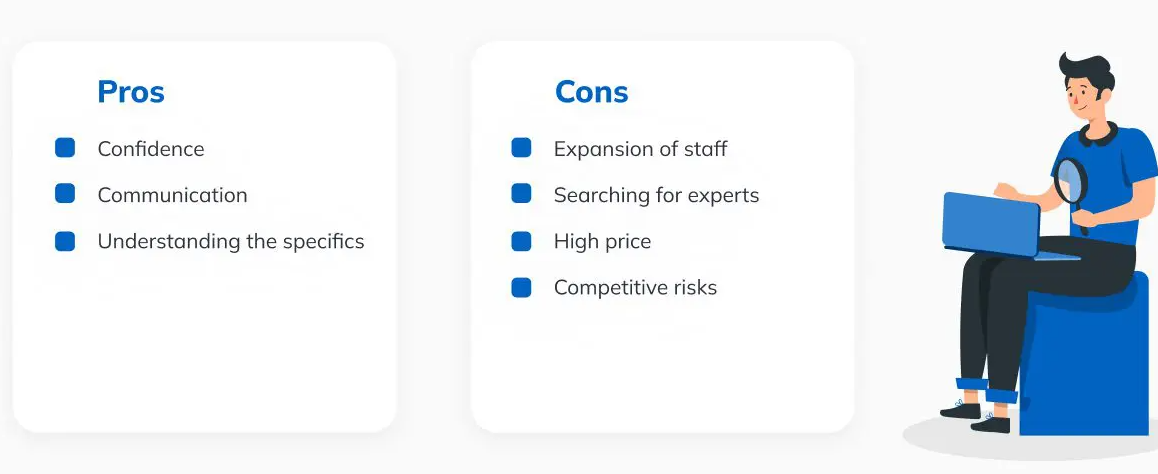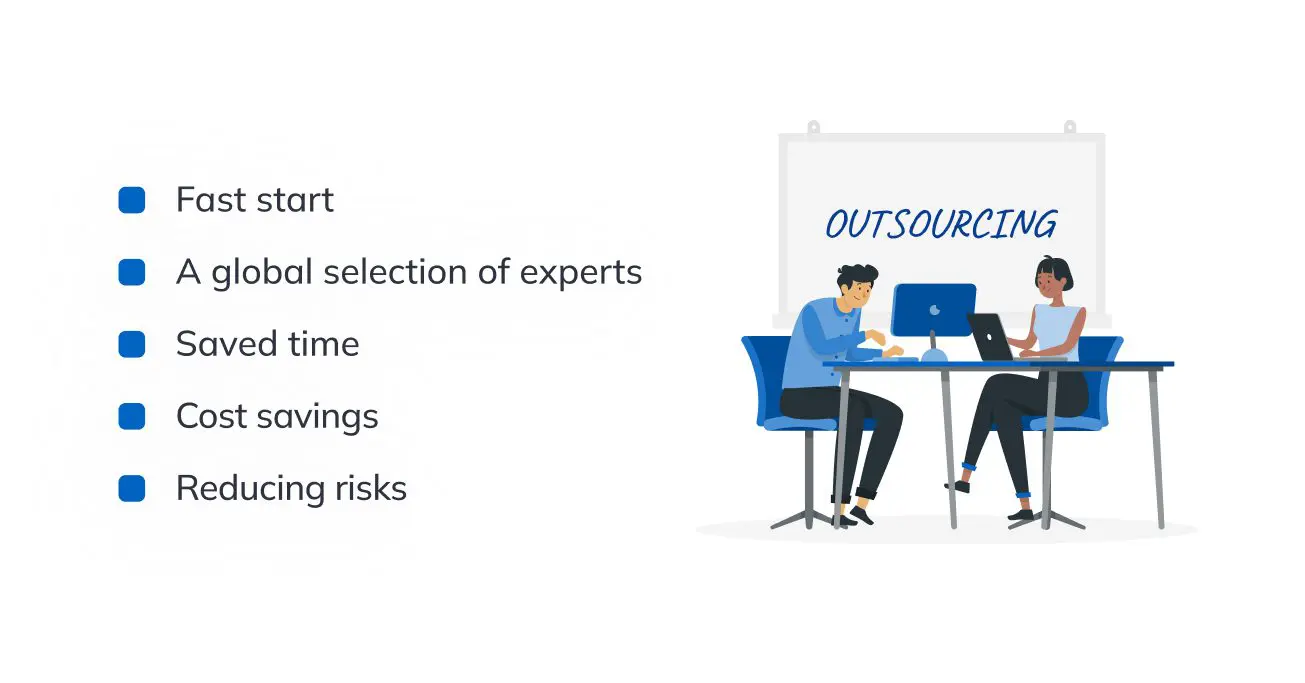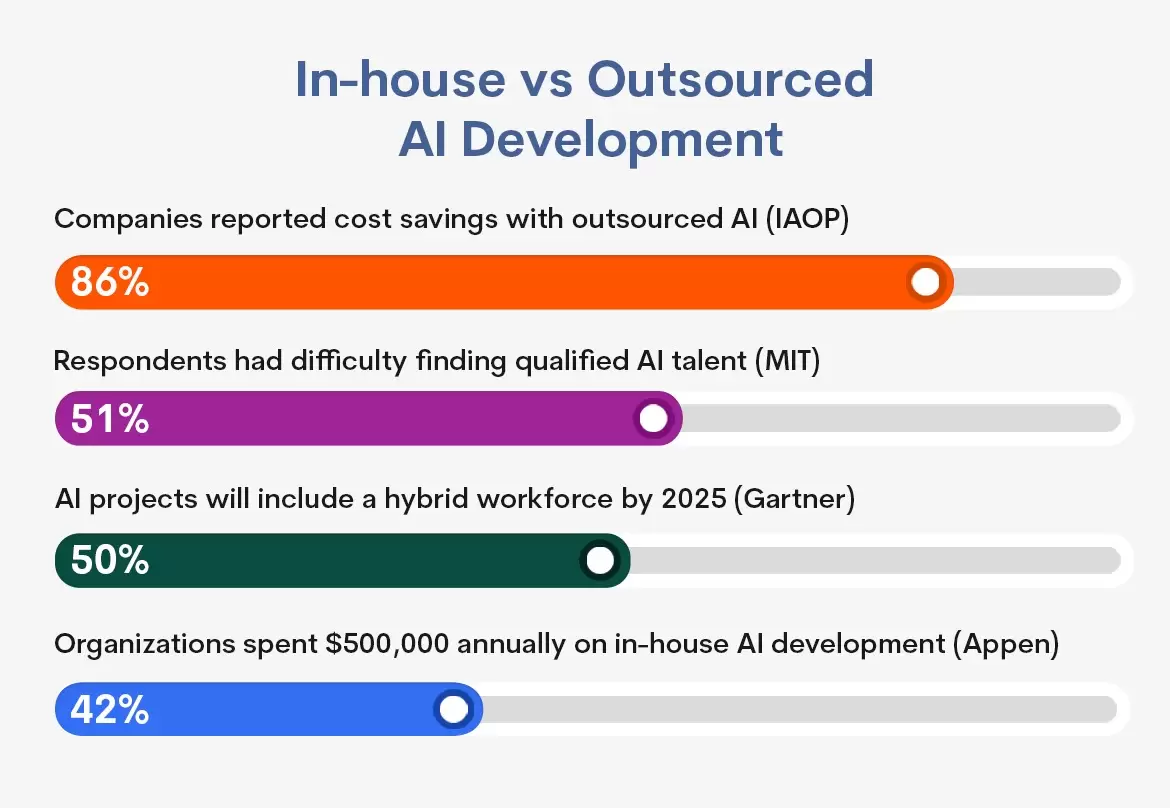Hiring a development team vs outsourcing your project
At some stage, every founder, regardless of their company's size, is faced with the dilemma of choosing between hiring an in-house development team or working with an outsourcing agency. Shouldn’t this be an easy one? You may ask why, well because 60% of the IT companies have chosen outsourcing their project as the number one option.
To sum up, the global IT market is estimated to reach USD $725.6 million by 2030 but we understand that still there’s a lot more to unravel in order to make the right choice.
This conundrum is poised mainly due to two reasons, either to develop new software or scale existing projects. While outsourcing is a common choice, if you don’t understand your unique needs, it would be incorrect to say that outsourcing might be the right choice for you as well. That is why you must be asking one of these questions to yourself.
- What would give me better output: building an in-house team or outsourcing the project to some IT company?
- Will I be able to retain the hired team while taking care of other expenses?
- Even if I want to build an in-house development team, how long will it take to train them and get onboarded with the project?
- What is the difference between the two and what budget needs to be set up?
- Will the outsourcing company be able to understand my vision?
If these questions resonate with you, you're in the right place. There's no universal answer, but understanding the nuances between in-house and outsourced teams is key. Let's delve into these factors.
What does it mean to hire an in-house development team?

In simple terms, it means that the founder or the hiring team posts regarding the job vacancies for different profiles such as developers, UI/UX designers and product managers, etc., and begins the process of hiring to build an in-house team to develop projects. These candidates go through a series of interviews and skillset tests to get hired.
How can hiring an in-house development team help you?
- Direct communication:
With the in-house team being at the same place, face-to-face communication is accessible. Any doubt or concern can be conveyed within seconds. - More control of the project’s progress:
Being in the same place enables the team to address issues promptly and fulfill tasks as instructed. - Culture and mindset synergy:
As the team works along and gets to know each other they collaborate and help each other to do better which eventually improves the performance. - Commitment and loyalty:
Being associated with people who share the same goals develops a sense of loyalty towards each other and the company.
What disadvantages could be faced?
It is true that hiring an in-house team does have benefits but there are certain disadvantages too, mentioned below.
- More capital investment:
Hiring a team comes with a lot of financial tangents. The cost of hiring an employee is around $4000 according to a Glassdoor study. It also includes paid sick leave, paid vacation days, and insurance. - Limited expertise and skills:
Due to different aspects of the project, the project might require a workforce with different skill sets but when it comes to hiring a new member it is time along with the efforts put into the training. Hence, there is limited access to the talent pool. - Upskilling:
As a new employee joins the company, new skills have to be learned, for which some capital has to be invested in training and development. It is a continuous process therefore a learning budget ought to be assigned. - High attrition:
Investing time and effort in an employee will not guarantee their stay at a company as they might get better compensation elsewhere. Usually, employees are on the lookout to switch companies for higher salaries within a span of 6 to 12 months which is really an expense for the company.
The details above have given you a good understanding of the advantages and disadvantages of hiring an in-house development team and whether it aligns with your needs. If this doesn't seem like the right fit for you, don't worry; we're about to dive into the world of outsourcing development. Keep reading!
What is outsourced development?

It is the act of delegating the development of software to a third party under NDA compliance. There are many IT development companies around the world. The outsourced agencies are estimated to grow by USD 701.88 billion by 2028 according to the GlobeNewswire. Some of the big names in the tech industry, outsource their projects such as Apple, Microsoft, and Google, giving a sense of trust to all those organisations that might be doubtful to go for an outsourcing agency.
If you are also looking for one such trustworthy company to hand over your project, let’s connect.
In case you choose to go for the latter one then you probably should know about what benefits you’ll reap and where it might lack.
What are some of the advantages of outsourcing a project?
- Diverse skill sets:
The outsourcing team members have prior experience with diverse projects, allowing them to choose the most suitable tools and methods for the business. This saves the founder significant time and resources that would otherwise be spent on training and compensating new employees for similar or new projects. - Effective time and budget:
Many outsourcing companies in countries like Ukraine, Poland, and Romania offer cost-effective software development teams with speedy delivery, enabling founders to allocate more capital to other crucial aspects of their business. - Scalability:
A team of people with a broad skill range makes it easier to take the venture to a new level due to their experience and expertise. This means in order to scale the project no extra capital, time, or effort will be arranged. - Proved an advantageous position:
With a team that has a wide array of competencies and has worked on multiple projects, gives them an edge over the in-house development team which needs more time to get trained.
Of course, you can’t be too careful so you need to know firsthand what all there is to know.
What are some of the pitfalls one can face when outsourcing a project?
- Communication gap:
The absence of a team being near or not being present in the same room results in a lack of communication which makes it much more challenging to address the concerns and might take up to 2 to 3 days. Outsourcing agencies usually work on multiple projects causing delays in the conveyance or even in setting up a meeting. - Restricted control:
Due to the language barrier and in some cases distinct time zones, it restricts open dialogue and constrains the emotions along with the worries. - Untrustworthiness:
Even though some of the big tech companies are outsourcing their projects still there is some sort of uncertainty to take a determined call though this concern can be resolved by signing an NDA form. - Uncertain quality:
Timely delivery doesn't guarantee quality. If re-work is needed, emails take days to be replied to, making the process of revision and review lengthy.
In order to overcome all these issues, we ensure to make a foolproof plan. Don't believe us? Let us show you a simple case study.
A case study: Creating software for a tech firm with Grorapid Labs
One of the founders came to us with a couple of problems he faced with his business. As a non-tech founder, he had a vision to create ERP software. However, he faced confusion about where to begin. We crafted a product roadmap that encompassed the entire software development lifecycle, majorly, in three-pointers:
- Addressing the problem,
- Identifying pain points, and
- Providing a solution.
We adhered to a well-defined plan to develop software that would alleviate all their challenges and, in the end, boost their business, as outlined below.
What were the problem statements of the company?
- Delayed deliveries and loss of assets.
- Lack of real-time tracking.
- Insufficient Integration with operational software.
What issues did they face?
- Inefficient asset monitoring
- Vehicle theft and security concerns.
- Lack of seamless integration.
What kind of app did the client want to create?
- Real-time location monitoring.
- Asset security and management.
- Streamlined logistics and operations.
How do Grorapid Labs help them?
- Customised solution implementation.
- API integration expertise.
- Data-driven decision-making.
Results obtained from the application:
- Decreased operational costs due to route optimization.
- Enhanced security due to real-time tracking.
- Improved efficiency and client satisfaction.
We take great pride in assisting people with their problems and if you have similar doubts, we can help you out.
An analysis has been put together below for your better understanding and to choose a more accurate option.
Factors to consider in the decision-making process

#Factor 1: Time and budget
- More time and budget to invest:
In-house development > Outsourced development
#Factor 2: Project deadlines
- Tight deadlines and deliverables:
In-house development < Outsourced development
#Factor 3: Specific technical requirements and expertise needed
- Assorted proficiencies::
In-house development < Outsourced development
#Factor 4: Complete control and monitoring
- Looking over the progress:
In-house development > Outsourced development
Practices to be adopted: In-house development team vs. an outsourced development team
Now that you are clear with both the preferences available and might even have made the choice, you might be wondering what you need to do in order to set up an in-house team or opting to outsource your project. For this reason, we have shared best practices available to build a sturdy team.
Best practices for hiring a productive in-house development team
1. Setting up a robust hiring system with interviews and skill tests along with effective retention strategies.
2. Ensuring a good work environment and making sure the team is not overburdened with work.
3. Well-deserved appraisals and work appreciation.
Best practices for hiring an outsourced development team
1. Proper research while choosing the right development agency.
2. Signing an NDA form to ensure that there is no breach of data and maintain a trustworthy cordial relationship.
3. All the necessary details, communication channels, and workflow have to be optimized from the beginning.
You have taken the first step to building your software, trust us and let us take your business to the next level.
Combining In-House and Outsourced Development: Harnessing the Benefits of Both

Considering the mentioned factors will enable you to make a well-informed decision for your business. If you have diverse projects and wish to test both methods, opting for the hybrid model could be a viable choice.
1. Making a choice between two viably good options is tough especially when they offer quality markers.
2. By employing an outsourced development team for 3 to 6 months will get the same work done, even better and faster than an in-house team.
3. The founder can save time and budget without compromising on timely delivery.
Hence, the major chunk of your project can be looked after by the in-house team and the specific developments can be done by the outsourced team.
Why choose Grorapid Labs for your outsourcing needs?
Grorapid Labs makes it their personal mission to maintain the quality of the project and ensure swift delivery. Grorapid Labs has been entrusted by several tech companies to build software and we ask you to take a chance on us.




